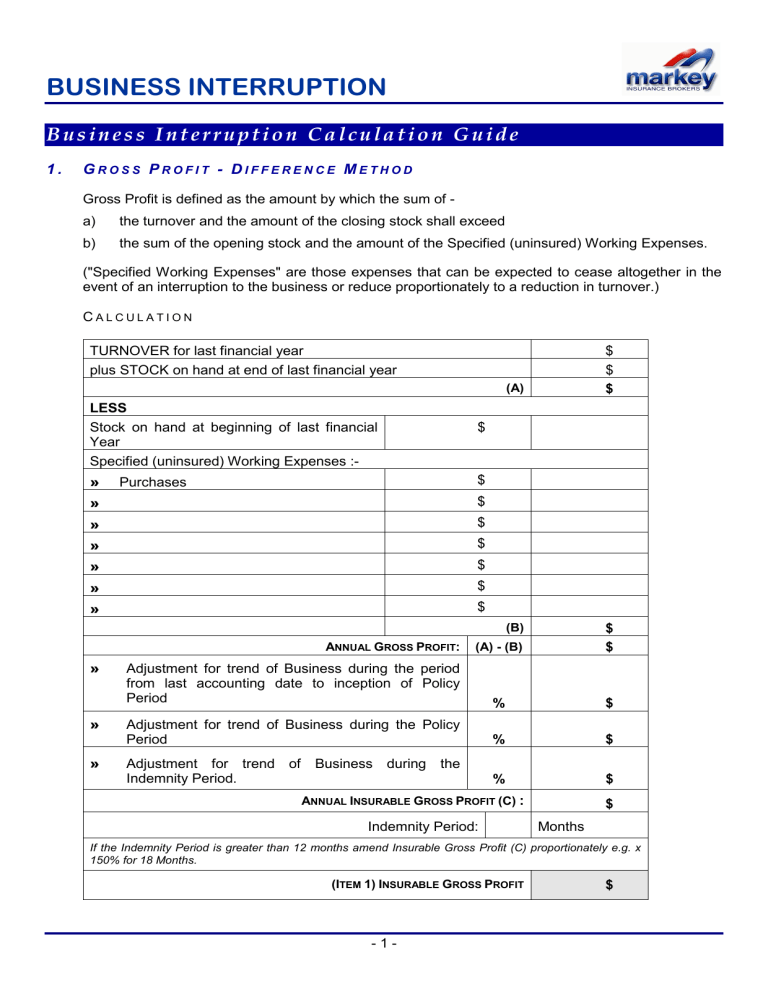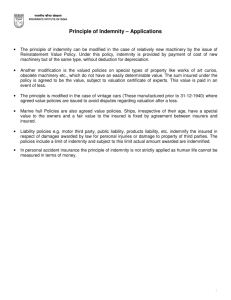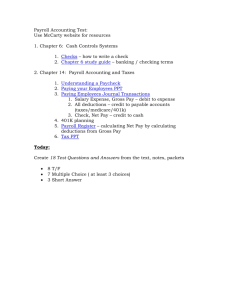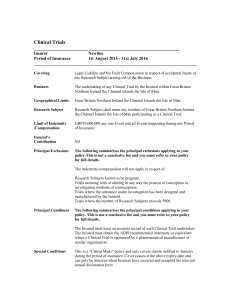Business Interruption Calculation Guide: Gross Profit & Payroll

BUSINESS INTERRUPTION
B u s i n e s s I n t e r r u p t i o n C a l c u l a t i o n G u i d e
1 . G R O S S P R O F I T D I F F E R E N C E M E T H O D
Gross Profit is defined as the amount by which the sum of - a) the turnover and the amount of the closing stock shall exceed b) the sum of the opening stock and the amount of the Specified (uninsured) Working Expenses.
("Specified Working Expenses" are those expenses that can be expected to cease altogether in the event of an interruption to the business or reduce proportionately to a reduction in turnover.)
C A L C U L A T I O N
TURNOVER for last financial year plus STOCK on hand at end of last financial year
(A)
LESS
Stock on hand at beginning of last financial
Year
Specified (uninsured) Working Expenses :-
$
» Purchases
»
$
$
»
$
»
»
»
»
$
$
$
$
(B)
A NNUAL G ROSS P ROFIT : (A) - (B)
» Adjustment for trend of Business during the period from last accounting date to inception of Policy
Period
%
» Adjustment for trend of Business during the Policy
Period %
» Adjustment for trend of Business during the
Indemnity Period. %
A NNUAL I NSURABLE G ROSS P ROFIT (C) :
$
$
$
$
Indemnity Period: Months
If the Indemnity Period is greater than 12 months amend Insurable Gross Profit (C) proportionately e.g. x
150% for 18 Months.
$
$
$
$
$
(I TEM 1) I NSURABLE G ROSS P ROFIT $
- 1 -
BUSINESS INTERRUPTION
2 . P A Y R O L L D U A L B A S I S
Payroll incorporates all personnel costs, including the following:
C A L C U L A T I O N
» Salaries and Wages Including Overtime
» Holiday Pay
» Sick Pay
» Long Service Leave Pay
» Commission and/or Bonuses
» Payroll Tax
» Fringe Benefits Tax
» Superannuation / Pension Fund Contributions
» Workers’ Compensation Insurance Premiums
A NNUAL P AYROLL :
» Adjustment for trend for Business during the period from last accounting date to inception of Policy
Period
» Adjustment for trend for Business during the Policy
Period
%
%
» Adjustment for trend for Business during the
Indemnity Period. %
A NNUAL I NSURABLE P AYROLL :
Indemnity Period: Months
D U A L P A Y R O L L B A S I S
$
$
Initial Period 100%
N
O
.
OF
W
EEKS
A
MOUNT
:
$
Remainder of Indemnity
Period
%
(I TEM 3) I NSURABLE P AYROLL
$
$
C ONSOLIDATED P ERIOD
For example : if 100% of Payroll is insured for the first 4 weeks & 50% is insured for the remaining 48 weeks of the Indemnity Period, the resulting declared value would be the equivalent of approximately 28 weeks payroll.
$
$
$
$
$
$
$
$
$
$
$
$
- 2 -
BUSINESS INTERRUPTION
C o n s e q u e n t i a l L o s s I n s u r a n c e
Consequential Loss Insurance (otherwise known as Business Interruption or Loss of Profits) complements insurance on material assets such as buildings, plant and stock. It is designed to provide protection against loss consequent upon interruption to a business as a result of damage to these assets by fire and other contingencies insured under a material damage policy, such as Fire and Extraneous Perils or Industrial
Special Risks.
A Consequential Loss policy provides cover for -
1. Loss of NET PROFIT due to a partial or total interruption to the business.
2. Payment of STANDING CHARGES such as rents, rates, taxes and salaries, which must be met even though the business may be partially or totally interrupted.
3. Payment of INCREASED COSTS OF WORKING incurred for the purpose of avoiding or diminishing a reduction in turnover during an interruption period. Examples of these costs are rent for temporary premises, hire of temporary plant, the cost of having work carried out at other premises, purchase of stock at inflated prices to fulfil contractual obligations and the payment of overtime and penalty rates to maintain production schedules.
D
E S I G N O F
C
O V E R
It is important that a Consequential Loss policy be tailored to suit each individual business. Three elements should be considered in determining the appropriate cover for your business:-
1. I NDEMNITY P ERIOD
This is the period during which the Insurer will pay for the loss of NET PROFIT and for STANDING
CHARGES and INCREASED COSTS OF WORKING after the damage occurs.
It is recommended that a minimum period of 12 months is selected and in the case of many businesses a longer period is warranted.
Some of the factors you should consider when selecting the period appropriate for your business are:- a) demolition and site clearance b) preparation of plans and approval by relevant authorities c) calling of tenders and awarding of contracts d) re-building e) replacement of damaged plant, some of which may have to be imported from overseas f) commission of plant to bring it to production capacity g) re-capture of lost business
- 3 -
BUSINESS INTERRUPTION
2. S UM I NSURED a) Gross Profit
The sum insured for GROSS PROFIT (i.e. NET PROFIT plus STANDING CHARGES) is normally arrived at by what is known as the DIFFERENCE METHOD which is explained in the accompanying Sum Insured Calculation Guide. b) Payroll
Ideally salaries and wages should be fully insured although this may be unwarranted in some instances, as it could be impractical and uneconomic to retain all employees during a long interruption period. Common practice is to insure the entire PAYROLL (salaries and wages) partially, the extent of cover being determined according to anticipated payroll costs in the event of a major interruption.
In such cases payroll is normally insured on what is known as the DUAL BASIS which is explained in the accompanying Sum Insured Calculation Guide. This basis provides flexibility in the treatment of payroll, enabling the Insured to decide after a loss how he wishes to apply the consolidated payroll cover derived from this method c) Additional Increased Costs of Working
The standard policy provides for increased costs necessarily and reasonably incurred for the sole purpose of avoiding or diminishing a reduction in turnover during the indemnity period.
The amount recoverable under the policy cannot, however, exceed the sum produced by applying the rate of gross profit to the amount of the reduction of turnover avoided by expending the increased costs.
If circumstances can be envisaged where costs at a rate in excess of this limit could be incurred in order to maintain turnover, provision should be made for ADDITIONAL INCREASED COSTS
OF WORKING. E.g. It may be necessary to purchase stock from another manufacturer at a cost in excess of a business's own production costs in order to meet an obligation to a customer. d) Claims Preparation Costs
Provision can be included to cover the fees charged by Accountants and the like to assist in the preparation of claims under both the Consequential Loss and Fire or Industrial Special Risks policies.
This can include payments to employees to perform this task but only for amounts in excess of what is normally paid for such employees' services. e) Business Trends
When calculating sums insured for Gross Profit & Payroll provisions must be made for anticipated trends in the business both during the period of the policy & the Indemnity Period.
Trend projections during the Indemnity Period should be made on the basis of a loss occurring on the last day of the policy period.
- 4 -
BUSINESS INTERRUPTION
3. S UPPLIERS ' / C USTOMERS ' P REMISES
If a fire or other insured contingency at the premises of one of your major suppliers (including subcontractors) or customers could affect your business, provision should be made for this eventuality under your policy.
Suppliers or customers for whom the degree of dependence of your business is less than 10% of your gross profit can usually be included without being individually specified. Those for whom there is a greater dependence must be specified and the dependence percentage nominated.
It’s good to be with Markey!
- 5 -






